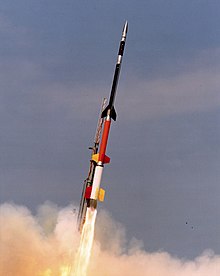Asounding rocketorrocketsonde, sometimes called a research rocket or a suborbital rocket, is an instrument-carrying rocket designed to take measurements and perform scientific experiments during its sub-orbital flight. The rockets are used to launch instruments from 48 to 145 km (30 to 90 miles)[1] above the surface of the Earth, the altitude generally between weather balloons and satellites; the maximum altitude for balloons is about 40 km (25 miles) and the minimum for satellites is approximately 121 km (75 miles).[2] Certain sounding rockets have an apogee between 1,000 and 1,500 km (620 and 930 miles), such as the Black Brant X and XII, which is the maximum apogee of their class. Sounding rockets often use military surplus rocket motors.[3] NASA routinely flies the Terrier Mk 70 boosted Improved Orion, lifting 270–450-kg (600–1,000-pound) payloads into the exoatmospheric region between 97 and 201 km (60 and 125 miles).[4]

The origin of the term comes from nautical vocabulary tosound, which is to throw a weighted line from a ship into the water to measure the water's depth. The term itself has its etymological roots in the Romance languages word for probe, of which there are nouns sonda and sonde and verbs like sondear which means "to do a survey or a poll". Sounding in the rocket context is equivalent to "taking a measurement".[3]
The basic elements of a sounding rocket are a solid-fuel rocket motor and a science payload.[3] Larger, higher altitude rockets have two to three stages to increase efficiency and payload capability. The freefall part of the flight is an elliptic trajectory with vertical major axis allowing the payload to appear to hover near its apogee.[2] The average flight time is less than 30 minutes; usually between five and 20 minutes.[2] The rocket consumes its fuel on the first stage of the rising part of the flight, then separates and falls away, leaving the payload to complete the arc and return to the ground under a parachute.[3]
Sounding rockets are advantageous for some research because of their low cost,[2] relatively short lead time (sometimes less than six months)[3] and their ability to conduct research in areas inaccessible to either balloons or satellites. They are also used as test beds for equipment that will be used in more expensive and risky orbital spaceflight missions.[2] The smaller size of a sounding rocket also makes launching from temporary sites possible, allowing field studies at remote locations, and even in the middle of the ocean, if fired from a ship.[5]
Weather observations, up to an altitude of 75 km, are done with rocketsondes, a kind of sounding rocket for atmospheric observations that consists of a rocket and radiosonde. The sonde records data on temperature, moisture, wind speed and direction, wind shear, atmospheric pressure, and air density during the flight. Position data (altitude and latitude/longitude) may also be recorded.
Common meteorological rockets are the Loki and Super Loki, typically 3.7 m tall and powered by a 10 cm diameter solid fuel rocket motor. The rocket motor separates at an altitude of 1500 m and the rest of the rocketsonde coasts to apogee (highest point). This can be set to an altitude of 20 km to 113 km.
Sounding rockets are commonly used for:
Due to the high military relevance of ballistic missile technology, there has always been a close relationship between sounding rockets and military missiles. It is a typical dual-use technology, which can be used for both civil and military purposes. During the Cold War, the Federal Republic of Germany cooperated on this topic with countries that had not signed the Non-Proliferation Treaty on Nuclear Weapons at that time, such as Brazil, Argentina and India. In the course of investigations by the German peace movement, this cooperation was revealed by a group of physicists in 1983.[7] The international discussion that was thus set in motion led to the development of the Missile Technology Control Regime (MTCR) at the level of G7 states. Since then, lists of technological equipment whose export is subject to strict controls have been drawn up within the MTCR framework.